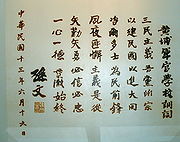National Anthem of the Republic of China

Sheet music
|
|
|
National anthem of the |
|
| Lyrics | From a speech by Sun Yat-sen, 1924 |
|---|---|
| Music | Cheng Maoyun, 1928 |
| Adopted | 1928 (de facto) 1943 (de jure) |
| Music sample | |
|
|
|
| National Anthem of the Republic of China | |||||||||||||||||||||||||

The original Whampoa Military Academy speech in Sun's handwriting.
|
|||||||||||||||||||||||||
| Traditional Chinese | 中華民國國歌 | ||||||||||||||||||||||||
|---|---|---|---|---|---|---|---|---|---|---|---|---|---|---|---|---|---|---|---|---|---|---|---|---|---|
| Simplified Chinese | 中华民国国歌 | ||||||||||||||||||||||||
| Hanyu Pinyin | Zhōnghuá Mínguó guógē | ||||||||||||||||||||||||
|
|||||||||||||||||||||||||
| Alternative Chinese name | |||||||||||||||||||||||||
| Traditional Chinese | 三民主義 | ||||||||||||||||||||||||
| Simplified Chinese | 三民主义 | ||||||||||||||||||||||||
| Hanyu Pinyin | Sānmín Zhǔyì | ||||||||||||||||||||||||
| Literal meaning | Three Principles of the People | ||||||||||||||||||||||||
|
|||||||||||||||||||||||||
| Transcriptions | |
|---|---|
| Standard Mandarin | |
| Hanyu Pinyin | Zhōnghuá Mínguó guógē |
| Bopomofo | ㄓㄨㄥ ㄏㄨㄚˊ ㄇㄧㄣˊ ㄍㄨㄛˊ ㄍㄨㄛˊ ㄍㄜ |
| Wade–Giles | Chung1-hua2 Min2-kuo2 kuo2-ke1 |
| Yale Romanization | Jung1 hwa2 Min2 gwo2 gwo2 ke1 |
| other Mandarin | |
| Xiao'erjing | ﺟْﻮ ﺧُﻮَ مٍ ﻗُﻮَع ﻗُﻮَع قْ |
| Yue: Cantonese | |
| Jyutping | zung1 waa4 man4 gwok3 gwok3 go1 |
| Southern Min | |
| Hokkien POJ | Tiong-hôa-bîn-kok Kok-koa |
| Transcriptions | |
|---|---|
| Standard Mandarin | |
| Hanyu Pinyin | Sānmín Zhǔyì |
| Wade–Giles | San1-min Chu3-i4 |
The latest National Anthem of the Republic of China was adopted in 1937; previously, Song to the Auspicious Cloud was used as the official anthem of the Republic of China (ROC). it remains the national anthem of the ROC government of Taiwan which remains there; but in mainland China, the anthem serves a historical role. The national anthem of the People's Republic of China is the "March of the Volunteers".
The anthem's words are adapted from a 1924 speech by Sun Yat-sen, via the anthem of the Chinese Nationalist Party (Kuomintang) in 1937. The lyrics relate to how the vision and hopes of a new nation and its people can be achieved and maintained. Informally, the song is sometimes known as San Min Chu-i from its opening line which references the Three Principles of the People (Sanmin Zhuyi), but this name is never used in formal or official occasions.
The text of was the collaboration between several Kuomintang (KMT) party members: Hu Hanmin, Dai Jitao, Liao Zhongkai, and Shao Yuanchong. The text debuted on July 16, 1924, as the opening of a speech by Sun Yat-sen at the opening ceremony of the Whampoa Military Academy. After the success of the Northern Expedition, the Kuomintang party chose the text to be its party anthem and publicly solicited for accompanying music. Cheng Maoyun won in a contest of 139 participants.
...
Wikipedia
